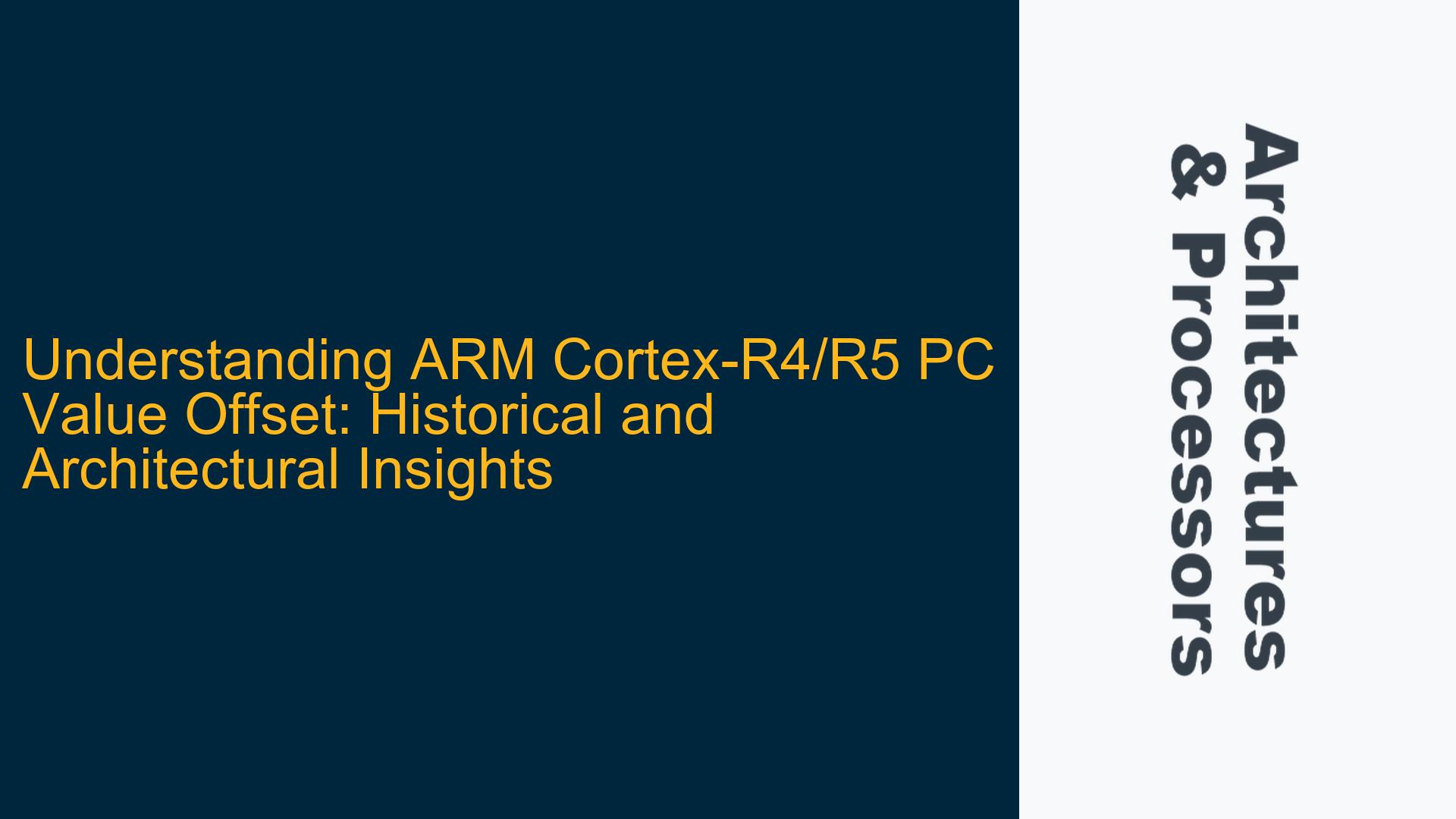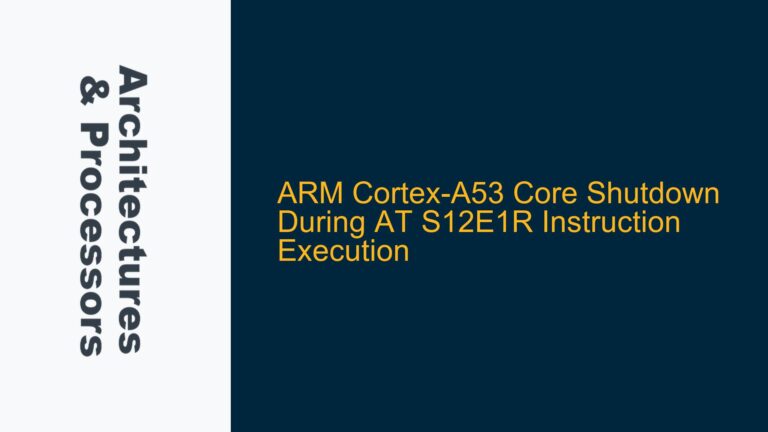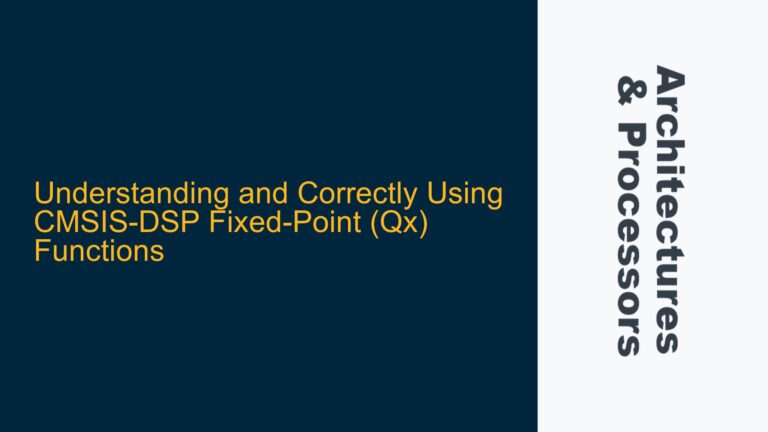ARM Cortex-R4/R5 PC Value Offset During Execution
The Program Counter (PC) in ARM Cortex-R4 and Cortex-R5 processors exhibits a behavior where it points 8 bytes ahead of the current instruction being executed. This offset is not a bug or an anomaly but a deliberate architectural design choice rooted in the history of ARM processors and their pipeline architecture. Understanding this behavior requires a deep dive into the ARM pipeline, the historical context of ARM architectures, and the implications for software development and debugging.
The ARM architecture employs a 3-stage pipeline (fetch, decode, execute) in its earlier designs, such as the ARM7TDMI. In these processors, the PC always points to the instruction being fetched, not the one being executed. Since each instruction is 4 bytes long in ARM state (32-bit instructions), the PC is effectively 8 bytes ahead of the instruction currently being executed. This behavior was carried forward into modern ARM cores like the Cortex-R4 and Cortex-R5 for compatibility reasons, even though these processors have more advanced pipelines.
The Cortex-R4 and Cortex-R5 processors are designed for real-time applications, where deterministic behavior and low latency are critical. The 8-byte PC offset is consistent with the ARM architecture’s historical design principles, ensuring backward compatibility with legacy code and tools. However, this behavior can be confusing for developers unfamiliar with ARM’s pipeline architecture, especially when debugging or analyzing disassembled code.
Historical Pipeline Design and Compatibility Constraints
The 8-byte PC offset in ARM Cortex-R4 and Cortex-R5 processors is a direct consequence of the 3-stage pipeline used in early ARM architectures. In a 3-stage pipeline, the processor fetches an instruction, decodes the previously fetched instruction, and executes the instruction fetched two cycles ago. This means the PC, which points to the instruction being fetched, is always two instructions ahead of the one being executed. Since each ARM instruction is 4 bytes long, the PC is 8 bytes ahead of the current execution point.
This behavior was preserved in later ARM architectures, including the Cortex-R4 and Cortex-R5, to maintain compatibility with existing software and development tools. Changing the PC behavior would have required significant changes to compilers, debuggers, and other tools, as well as potentially breaking existing code that relies on the 8-byte offset. For example, some code might use the PC to calculate relative addresses or perform position-independent operations, which would fail if the PC offset were changed.
The Cortex-R4 and Cortex-R5 processors also feature more advanced pipeline designs, including out-of-order execution and branch prediction. However, the PC offset remains consistent with the original ARM pipeline behavior to ensure compatibility. This design choice highlights the importance of backward compatibility in embedded systems, where legacy code and tools often play a critical role in system development.
Debugging and Development Implications of the PC Offset
The 8-byte PC offset in ARM Cortex-R4 and Cortex-R5 processors has several implications for debugging and software development. First, developers must be aware of this behavior when interpreting the PC value during debugging. For example, if a breakpoint is set at a specific address, the PC will point 8 bytes ahead when the breakpoint is hit. This can be confusing if the developer expects the PC to point to the current instruction.
Second, the PC offset affects position-independent code and relative addressing. For example, when calculating the address of a label or function using the PC, developers must account for the 8-byte offset. Failure to do so can result in incorrect address calculations and runtime errors. The following example illustrates this issue:
LDR R0, [PC, #offset] ; Load address relative to PC
In this case, the offset must account for the 8-byte PC offset to correctly calculate the target address. Developers must also be cautious when using the PC for branching or subroutine calls, as the offset can affect the target address.
Third, the PC offset can impact performance analysis and optimization. For example, when profiling code or analyzing execution traces, the PC value must be adjusted to reflect the actual instruction being executed. This adjustment is necessary to accurately identify performance bottlenecks and optimize critical code paths.
To address these challenges, developers can use tools and techniques that account for the PC offset. For example, debuggers and disassemblers can automatically adjust the PC value to reflect the current instruction. Additionally, developers can use macros or helper functions to handle PC-relative calculations, ensuring correct address computation.
In conclusion, the 8-byte PC offset in ARM Cortex-R4 and Cortex-R5 processors is a deliberate design choice rooted in the ARM architecture’s historical pipeline design. While this behavior can be confusing for developers, understanding its origins and implications is essential for effective debugging and software development. By accounting for the PC offset and using appropriate tools and techniques, developers can ensure accurate and efficient code execution on ARM Cortex-R4 and Cortex-R5 processors.






